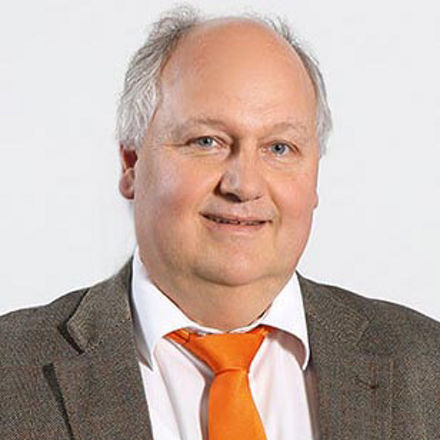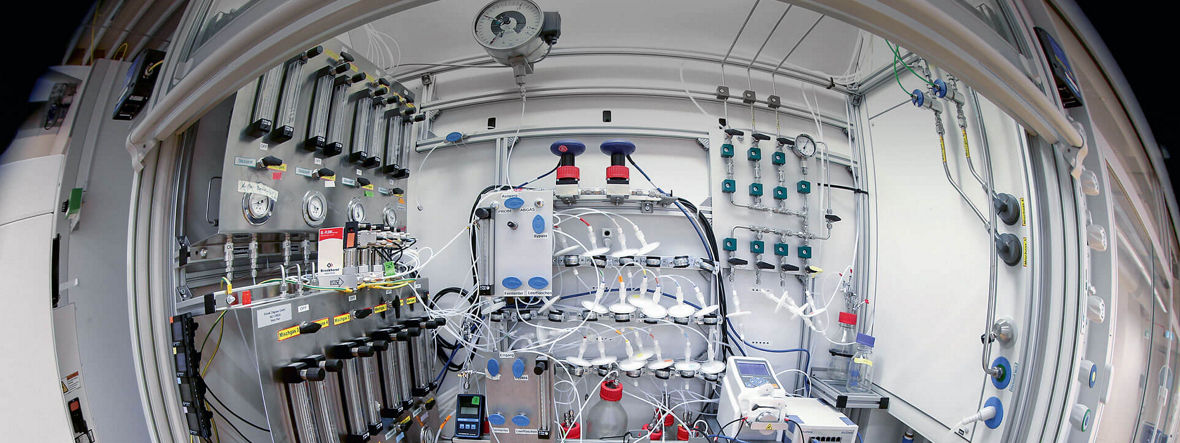Sunlight, carbon dioxide (CO2), and water are all that green plants need for photosynthesis, the most important process for building biomass; over time, this produces a mighty tree from a tiny plant. It seems simple enough on the surface—but when chemists and engineers try to emulate what seems to work so easily in nature, they have so far been faced with almost insuperable problems. In the Rheticus project, Siemens and Evonik now plan to show that artificial photosynthesis is feasible using renewable energy: from carbon dioxide, water, and energy, valuable specialty chemicals are obtained by a combination of chemical and biological steps.
As long ago as the 1970s, serious efforts were being made to implement the concept of artificial photosynthesis. But despite many small successes in certain areas, the big breakthrough that would allow the process to be used cost-effectively and over a broad front has so far failed to materialize. Now Rheticus could change all that. In the year 2021, the first test plant will go on stream at Evonik’s Marl site in North Rhine-Westphalia to produce chemicals like butanol and hexanol, both of which are starting materials for specialty polymers and dietary supplements, for example.
Rheticus is linked to the Kopernikus initiative for the energy transition in Germany, which seeks new solutions for a restructuring of the energy system. During Kopernikus—in which Evonik and Siemens are also participating—the focus is on basic research; Rheticus, on the other hand, aims to rapidly put the technology into practice. The German Federal Ministry of Education and Research is supporting Rheticus to the tune of €2.8 million during the first financing phase and €3.5 million in the second, with the two industrial groups investing roughly the same amount.
With this project, Siemens and Evonik are providing an answer to one of the central questions of the energy transition: how can volatile renewable energy be meaningfully used and intelligently stored?
Rheticus illustrates the power inherent in merging the energy and chemical sectors. Using power-to-X concepts—which describe how power can be used to produce chemicals, gases, and fuels—electrical energy that cannot be stored is converted into a form that can be stored over extended periods. In this way the chemical industry can contribute to what is known as sector coupling, in which power from renewable energies can be utilized as efficiently as possible—for example, to power electric vehicles in the transport sector, for methane production in heat supply, or in the chemical industry to produce specialty chemicals. With Rheticus, power is used to produce energy-rich organic compounds that are then directly used as specialty chemicals to add value.
RHETICUS SMOOTHS THE WAY IN INDUSTRIAL APPLICATION
The two processes that Rheticus links together have been known for a long time—and yet are quite new. Electrolysis, for example, has been used since the late 19th century for the industrial production both of chlorine and of sodium and potassium hydroxide solutions. In Rheticus, however, Siemens is pioneering the use of a CO2 electrolyzer in industrial application. In this device, water is oxidized to oxygen (O2) at the positive terminal (a titanium anode coated with iridium oxide), while the negative terminal, a silver gas-diffusion cathode, is flushed with CO2 Here, the electrical current reduces part of the gas to carbon monoxide (CO) along with small amounts of hydrogen H2. When combined with the hydrogen produced via electrolysis, this yields synthesis gas, a mixture of CO2, CO, and H2.
For the subsequent bacterial fermentation, the synthesis gas must be as free from oxygen as possible. This is because two different bacterial strains are used in Rheticus that are inhibited or even killed off by oxygen. Life scientists therefore describe these Clostridia as obligate anaerobes. In industrial biotechnology they are true exotics. The decision of the experts at Creavis, Evonik’s strategic research unit, to use these bacteria is no coincidence. In contrast to commonly used microorganisms, such as Escherichia coli , they bring an invaluable advantage to Rheticus: the two Clostridia species used produce the alcohols hexanol and butanol naturally.
This simplifies strain development. Moreover, if the wild-type strains are also used for production, plants can be more simply designed—without the additional safety measures that are required for handling genetically modified microorganisms. Clostridia grow in the absence of oxygen, which also helps maintain the cleanliness of the plant: microorganisms in the ambient air do not thrive, and cannot survive in this atmosphere that is so hostile to them.
Plans for the pilot plant include a fermenter in which both Clostridia strains grow in what is known as a co-culture. In the bioreactor the incoming synthesis gas is first metabolized by Clostridium autoethanogenum to acetate and ethanol. Both of these molecules then serve as starting materials for the bacterium Clostridium kluyveri to produce butyrate and hexanoate. In the final step, these two compounds are reduced, again by C. autoethanogenum, to butanol and hexanol.

»In the Rheticus project we’re developing a platform for manufacturing chemical products in a profitable and environment-friendly«
GÜNTER SCHMID Dr. Günter Schmid is responsible for technical aspects of the Rheticus project at Siemens Gas & Power.
MODULARITY TO ENSURE FLEXIBILITY
One special feature of the platform is its modular structure. The electrolyzer and fermenter have been designed as independent units. This allows the plant size to be scaled as desired and adapted for local conditions. The possibility of developing further modules also offers unprecedented flexibility in relation to raw-material sources and the products produced. In conjunction with C. autoethanogenum, the bacterial species Pelobacter propionicus, also an obligate anaerobe, could metabolize, for example, CO2 and ethanol to acetate and propionate. Oleaginous yeasts would be able to convert the substances formed from C. autoethanogenum into lipids. These are just two examples illustrating the potential of artificial photosynthesis, which would allow numerous chemicals and fuels to be produced in a manner that is profitable and environmentally sound. Furthermore, the platform also serves as an energy store and can respond to power fluctuations.
The electrolyzer and fermenter units are designed so that they can operate continuously but need not always run at full capacity. Solutions based on this system could therefore make it possible one day to provide the extremely important balancing energy that must be available within seconds for stabilizing the grid.
Siemens develops and is already selling H2 electrolyzers that meet these stringent demands; in principle it could do the same for the CO2 electrolyzers used in the Rheticus project. There are no serious concerns that fluctuating power supply could cause problems for the bacteria: in nature, after all, they have successfully coped with changing conditions for millions of years.

»We want to show that artificial photosynthesis is feasible«
THOMAS HAAS Dr. Thomas Haas is responsible for the Rheticus project at Creavis, Evonik’s strategic innovation unit.
SCALING UP TO INDUSTRIAL SCALE IS POSSIBLE
A way in which a relatively small plant could be designed for industrial use is described in a recent issue of the scientific journal Nature Catalysis (doi:10.1038/ s41929-017-0005-1). According to this, a plant that could produce 10,000 metric tons of hexanol and butanol within a year would consume about 25.5 megawatts. Depending on location, weather conditions, Dr. Günter Schmid is the technical project responsible of the Rheticus project at Siemens Corporate Technology “In the Rheticus project we’re developing a platform for manufacturing chemical products in a much more cost-effective and environment-friendly way than the processes we’re using today” GÜNTER SCHMID and the type of photovoltaic modules installed, this corresponds approximately in Germany to the annual energy output of solar modules with an area of 0.15 square kilometers. By way of comparison, according to estimates by the Fraunhofer Institute for Solar Energy Systems, all the photovoltaic modules installed in Germany up to the start of 2018, with a total power rating of 40 gigawatts, cover an area of about 300 square kilometers.
About 25,000 metric tons of CO are needed annually to produce 10,000 metric tons of hexanol and butanol. This gas is abundantly available, as the German Federal Environment Agency has found that about 45 million metric tons of CO2 emissions arise annually from industrial processes in Germany. Rheticus is therefore preparing the way for utilizing what is by far the most important greenhouse gas as a raw material, and thus preventing it from entering the atmosphere in the first place.
The researchers have also worked out in this publication how the scale-up could be effected. To process 25,000 metric tons of CO2 the electrolyzer would have to be scaled up by a factor of 270,000 – by, for example, increasing the electrode surface from 10 square centimeters to 1 square meter and operating 270 cells in parallel. This is not unrealistic: Both have already been implemented in other electrolyzers.
For the fermentation in the laboratory, the researchers use two one-liter bioreactors. To produce 10,000 metric tons of alcohols annually, the production rate would have to be increased by a factor of 21.6 million – by, for example, increasing the cell density in the fermenters by a factor of 30 and the volume of the tanks to 700,000 liters. These figures have also already been attained in other industrially used biotechnological processes.
CHEMISTRY FOLLOWS THE BEST AVAILABLE ENERGY FORM
Over the next two years about 20 Evonik and Siemens employees will be working hard to transfer Rheticus from the lab into a technical test plant on the 25-metric- ton scale. A few questions remain to be answered: How should the interfaces between electrolyzer and fermenter be designed? Will anaerobic Clostridia also pass the test on the industrial scale? Will it be possible to design a fully continuous process with the two modules?
Despite these challenges, there has never been a better time than the present to contribute to the energy transition and create a new energy base for the chemical industry with a project like Rheticus. Looking back at the past, it is clear that in choosing its raw materials the chemical industry has always followed the best available energy form. A hundred years ago, coal chemistry was in its element, followed a few decades later by the golden age of petrochemistry. Thanks not least to the development of renewable energies, the availability of electrical energy over the last few years has been improving steadily and this trend is expected to continue. Electrical power is therefore of interest even for the energy- intensive processes of the chemical industry. An increasing number of experts expect an electrification of the chemical industry in the future. Rheticus shows one way that this could be achieved, thus affording a glimpse into the future.
Georg Joachim Rheticus Astronomer and mathematician
Georg Joachim Rheticus (* February 16, 1514 in Feldkirch; † December 4, 1574 in Kaschau) was an astronomer and a mathematician. Rheticus was one of the first scholars to disseminate the heliocentric theory of Nicolaus Copernicus, according to which the sun—in contrast to the Christian doctrine of that era—does not orbit the Earth. He studied with Copernicus, an astronomer and physician, for two years as his sole student, encouraging him to complete his work and publish it. In 1551 Rheticus published the most significant of his own works, the Canon doctrinae triangulorum, which included many trigonometric tables.
Feldkirch: city in Vorarlberg (Austria)
Kaschau: now Košice (Slovakia)
Nikolaus Kopernikus: astronomer, 1473–1543


